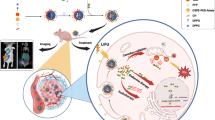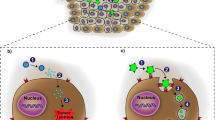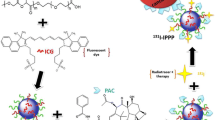Abstract
mTOR inhibitors are recently important tools for cancer treatment. They act on cell growth regulation, proliferation, and survival. Pharmacological therapy with mTOR inhibitors such as everolimus is emerging as an alternate approach. Meanwhile, early diagnosis is a hot target in cancer research. Conversely, it can be a novel diagnosis approach to monitor mTOR inhibitors during their pathway. From this point of view, radiolabeling of everolimus and its nanoformulation (EVE-PLGA nanoparticles) in high yields (95%) with an important diagnostic radionuclide (technetium-99m) is described. Besides, in vitro incorporation assays of radiolabeled everolimus and its nanoformulation against the cervix and ovarian cancer cells were demonstrated 8- and 12-times high values than control group. In conclusion, radiolabeled everolimus and its nanoformulation have a promise to improve on monitoring mTOR inhibitors.






Similar content being viewed by others
References
Faes S, Demartines N, Dormond O (2017) Resistance to MTORC1 inhibitors in cancer therapy: From kinase mutations to intratumoral heterogeneity of kinase activity. Oxid Med Cell Longev. https://doi.org/10.1155/2017/1726078
Estimated Cancer Prevalence Worldwide in 2020 http://globocan.iarc.fr (accessed Jul 10, 2021).
de Melo AC, Paulino E, Garces ÁHI (2017) A review of MTOR pathway inhibitors in gynecologic cancer. Oxid Med Cell Longev 2017:4809751. https://doi.org/10.1155/2017/4809751
Assad DX, Elias ST, Melo AC, Ferreira CG, De Luca Canto G, Guerra ENS (2016) Potential impact of MTOR inhibitors on cervical squamous cell carcinoma: A systematic review. Oncol Lett 12(5):4107–4116. https://doi.org/10.3892/ol.2016.5157
Zou Z, Tao T, Li H, Zhu X (2020) MTOR signaling pathway and MTOR inhibitors in cancer: progress and challenges. Cell Biosci 10(1):1–11. https://doi.org/10.1186/S13578-020-00396-1
Feng Y, Chen X, Cassady K, Zou Z, Yang S, Wang Z, Zhang X (2021) The role of MTOR inhibitors in hematologic disease: from bench to bedside. Front Oncol 10:3043. https://doi.org/10.3389/FONC.2020.611690
de Melo AC, Grazziotin-Reisner R, Erlich F, Fontes Dias MS, Moralez G, Carneiro M, Ingles Garces ÁH, Guerra Alves FV, Novaes Neto B, Fuchshuber-Moraes M et al (2016) A phase i study of MTOR inhibitor everolimus in association with cisplatin and radiotherapy for the treatment of locally advanced cervix cancer: PHOENIX I. Cancer Chemother Pharmacol. https://doi.org/10.1007/s00280-016-3064-0
Wang M, Gao M, Miller KD, Sledge GW, Zheng QH (2012) [11C]GSK2126458 and [18F]GSK2126458, the first radiosynthesis of new potential PET agents for imaging of PI3K and MTOR in cancers. Bioorg Med Chem Lett 22(4):1569–1574. https://doi.org/10.1016/J.BMCL.2011.12.136
Kinross KM, Brown DV, Kleinschmidt M, Jackson S, Christensen J, Cullinane C, Hicks RJ, Johnstone RW, McArthur GA (2011) In Vivo activity of combined PI3K/MTOR and MEK inhibition in a KrasG12D;Pten deletion mouse model of ovarian cancer. Mol Cancer Ther 10(8):1440–1449. https://doi.org/10.1158/1535-7163.MCT-11-0240
Majo VJ, Simpson NR, Prabhakaran J, Mann JJ, Kumar JSD (2014) Radiosynthesis of [18F]ATPFU: A potential PET Ligand for MTOR. J. Labelled Comp. Radiopharm. 57(13):705. https://doi.org/10.1002/JLCR.3239
Han N, Jiang Y, Gai Y, Liu Q, Yuan L, Wang Y, Lan X (2019) 11 C-labeled pictilisib (GDC-0941) as a molecular tracer targeting Phosphatidylinositol 3-Kinase (PI3K) for breast cancer imaging. Contrast Media Mol Imaging. https://doi.org/10.1155/2019/1760184
Altine B, Gai Y, Han N, Jiang Y, Ji H, Fang H, Niyonkuru A, Bakari KH, Arnous MMR, Liu Q et al (2019) Preclinical evaluation of a Fluorine-18 (18F)-Labeled phosphatidylinositol 3-Kinase inhibitor for Breast cancer imaging. Mol Pharm 16(11):4563–4571. https://doi.org/10.1021/ACS.MOLPHARMACEUT.9B00690
Rashidi S, Mansouri R, Ali-Hassanzadeh M, Mojtahedi Z, Shafiei R, Savardashtaki A, Hamidizadeh N, Karimazar M, Nguewa P, Manzano-Román R (2021) The host MTOR pathway and parasitic diseases pathogenesis. Parasitol Res. https://doi.org/10.1007/s00436-021-07070-6
Santulli G, Totary-Jain H (2013) Tailoring MTOR-based therapy: Molecular evidence and clinical challenges. Pharmacogenomics 14(12):1517–1526. https://doi.org/10.2217/pgs.13.143
André F, O’Regan R, Ozguroglu M, Toi M, Xu B, Jerusalem G, Masuda N, Wilks S, Arena F, Isaacs C et al (2014) Everolimus for women with trastuzumab-resistant, HER2-positive, advanced Breast cancer (BOLERO-3): A randomised, double-blind, placebo-controlled phase 3 trial. Lancet Oncol 15(6):580–591. https://doi.org/10.1016/S1470-2045(14)70138-X
Ge J, Zhang Q, Zeng J, Gu Z, Gao M (2020) Radiolabeling nanomaterials for multimodality imaging: New insights into nuclear medicine and cancer diagnosis. Biomaterials. https://doi.org/10.1016/j.biomaterials.2019.119553
Yurt Kilcar A, Tekin V, Biber Muftuler FZ, Medine EI (2016) 99mTc labeled plumbagin: Estrogen receptor dependent examination against Breast cancer cells and comparison with PLGA encapsulated form. J Radioanal Nucl Chem 308(1):13–22. https://doi.org/10.1007/s10967-015-4284-1
Yurt Kilcar A, Biber Muftuler FZ, Medine EI, Tekin V (2016) PLGA encapsulation effect on Bioquin-HMPAO: Radiolabeling and in Vitro behaviour on Brain and Lung cancer cells. J Radioanal Nucl Chem 310(1):155–164. https://doi.org/10.1007/s10967-016-4746-0
Brannon-Peppas L (1995) Recent advances on the use of biodegradable microparticles and nanoparticles in controlled drug delivery. Int J Pharm 116(1):1–9. https://doi.org/10.1016/0378-5173(94)00324-X
Peltonen L, Koistinen P, Karjalainen M, Häkkinen A, Hirvonen J (2002) The effect of cosolvents on the formulation of nanoparticles from low-molecular-weight Poly(l)Lactide. AAPS PharmSciTech 3(4):E32. https://doi.org/10.1208/pt030432
Yildiz G, Yurt Kilcar A, Medine EI, Tekin V, Kozgus Guldu O, Biber Muftuler FZ (2017) PLGA encapsulation and radioiodination of Indole-3-Carbinol: Investigation of anticancerogenic effects against MCF7, Caco2 and PC3 cells by in Vitro assays. J Radioanal Nucl Chem 311(2):1043–1052. https://doi.org/10.1007/s10967-016-4929-8
Zolle I (2007) Technetium-99m pharmaceuticals preparation and quality control in nuclear medicine
Meek WH, Fuchsman CH (1969) Carboxylation of substituted phenols in N, N-Dimethylamide solvents at atmospheric pressure. J Chem Eng Data 14:388–391
Houdaihed L, Evans JC, Allen C (2019) In Vivo evaluation of dual-targeted nanoparticles encapsulating paclitaxel and everolimus. Cancers (Basel). https://doi.org/10.3390/CANCERS11060752
Bonizzi A, Truffi M, Sevieri M, Allevi R, Sitia L, Ottria R, Sorrentino L, Sottani C, Negri S, Grignani E et al (2019) Everolimus nanoformulation in biological nanoparticles increases drug responsiveness in resistant and low-responsive breast cancer cell lines. Pharm 11(8):384. https://doi.org/10.3390/PHARMACEUTICS11080384
Theobald A (1989) Radiopharmaceuticals using radioactive compounds in pharmaceutics and medicine.
Schwochau K (2000) Technetium chemistry and radiopharmaceutical applications. Wiley-VCH, Winheim
Pusapati RV, Daemen A, Wilson C, Sandoval W, Gao M, Haley B, Baudy AR, Hatzivassiliou G, Evangelista M, Settleman J (2016) MTORC1-Dependent metabolic reprogramming underlies escape from glycolysis addiction in cancer cells. Cancer Cell 29(4):548–562. https://doi.org/10.1016/j.ccell.2016.02.018
Assad DX, Borges GA, Avelino SR, Guerra ENS (2018) Additive cytotoxic effects of radiation and MTOR inhibitors in a cervical cancer cell line. Pathol Res Pract 214(2):259–262. https://doi.org/10.1016/j.prp.2017.10.019
Acknowledgements
Current work is supported by Ege University Scientific Research Projects Coordination Unit (Project No. 17-TIP-046 (ID:109)). The authors thank to Fatmagül Gedik, Neşe Kavcar and Öykü Madenci for the technical assistance during the assays. A limited part of the synthesis and radiolabeling part was presented as a poster presentation at 44th FEBS Congress, From Molecules to Living Systems, Krakow, Poland, July 6-11, 2019.
Author information
Authors and Affiliations
Corresponding author
Additional information
Publisher's Note
Springer Nature remains neutral with regard to jurisdictional claims in published maps and institutional affiliations.
Rights and permissions
About this article
Cite this article
Bilgi, A., Yurt Kilcar, A., Gokulu, S.G. et al. mTOR inhibitors from a diagnostic perspective: radiolabeling of everolimus and its nanoformulation, in vitro incorporation assays against cervix and ovarian cancer cells. J Radioanal Nucl Chem 331, 171–178 (2022). https://doi.org/10.1007/s10967-021-08066-3
Received:
Accepted:
Published:
Issue Date:
DOI: https://doi.org/10.1007/s10967-021-08066-3




